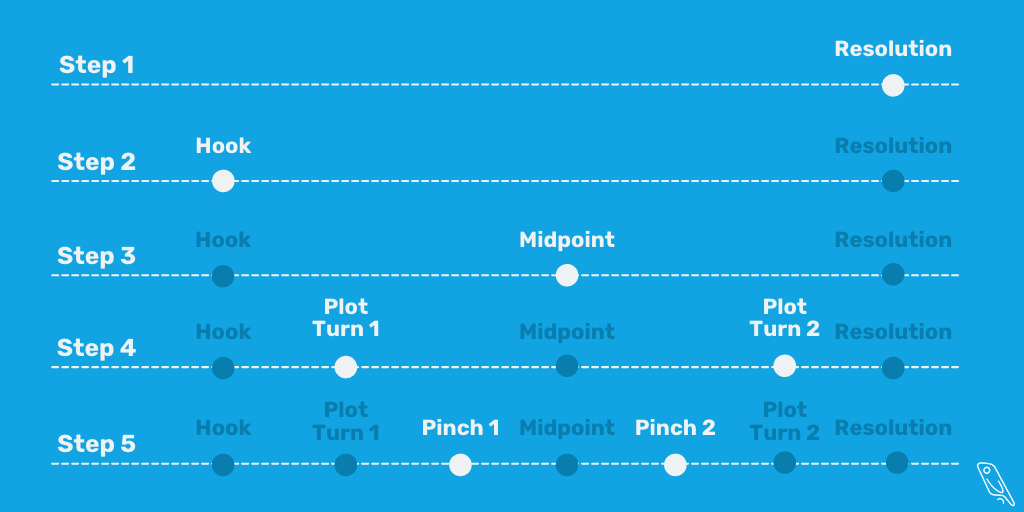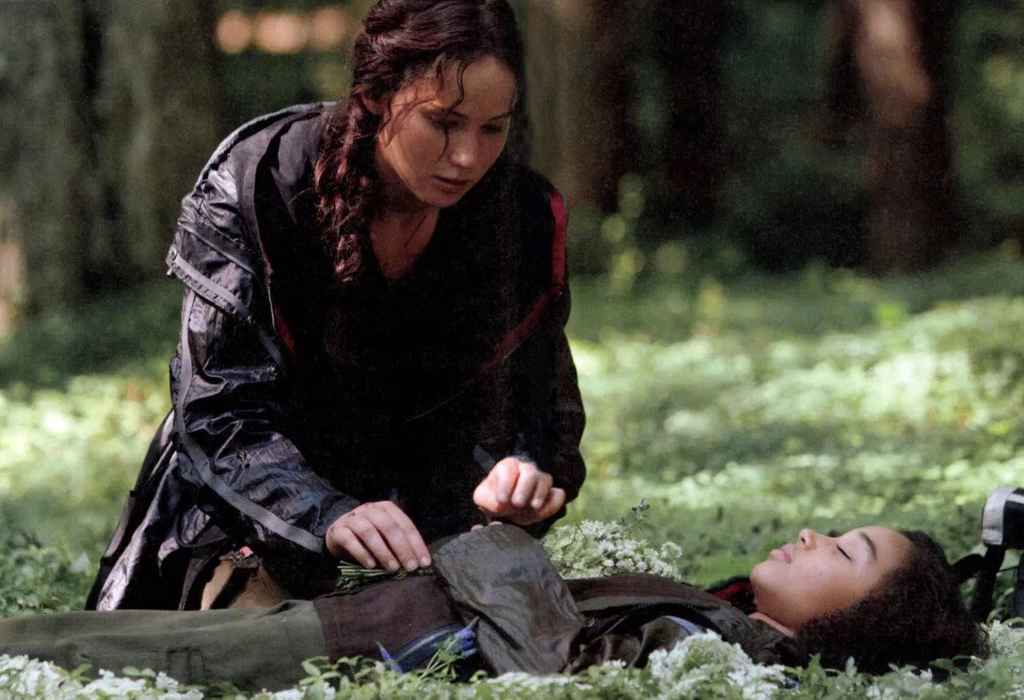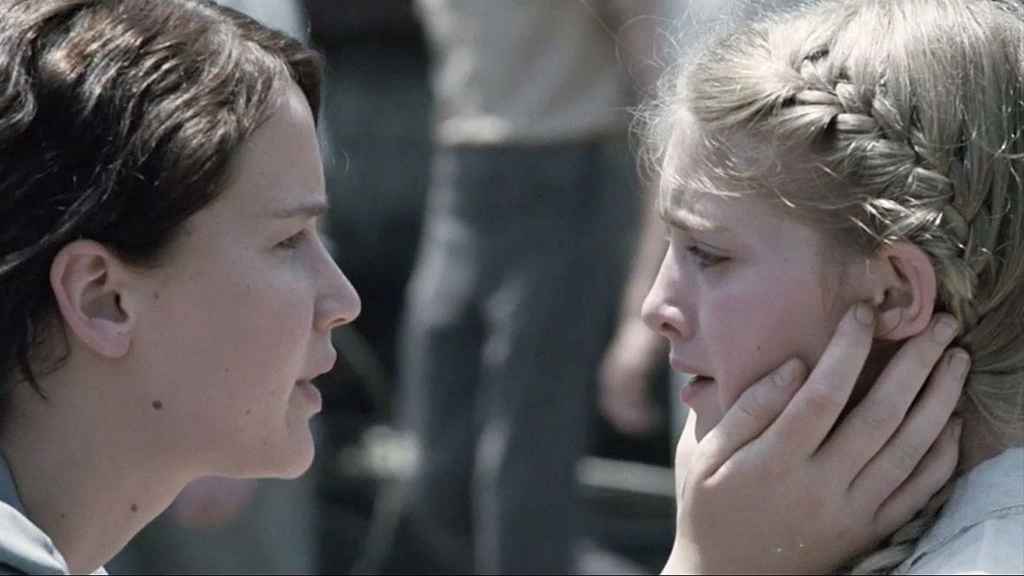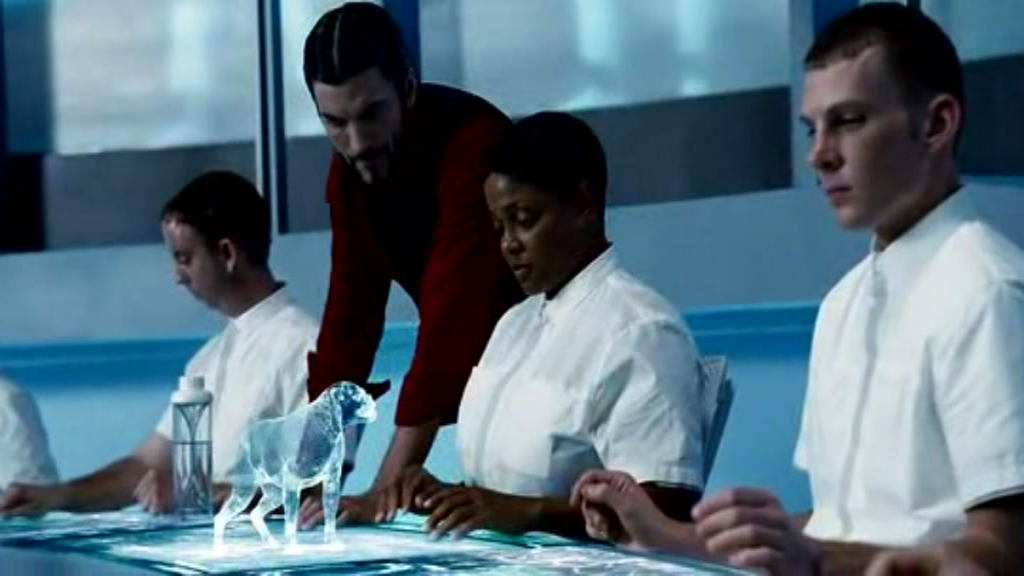Guides • Perfecting your Craft
Posted on Apr 14, 2021
The Seven-Point Story Structure: From Idea to Plot in 5 Steps
About the author
Reedsy's editorial team is a diverse group of industry experts devoted to helping authors write and publish beautiful books.
More about the Reedsy Editorial Team →Dario Villirilli
Editor-in-Chief of the Reedsy blog, Dario is a graduate of Mälardalen University. As a freelance writer, he has written for many esteemed outlets aimed at writers. A traveler at heart, he can be found roaming the world and working from his laptop.
View profile →The Seven-Point structure is a relatively new player in the world of story structures, but it’s here’s to stay. It was first popularized by sci-fi author and RPG-enthusiast Dan Wells at the 2013 Life, the Universe, & Everything conference. He took the structure outlined in the Star Trek Roleplaying Game Narrator’s Guide and turned it into a system that he and many other authors claim to have used to build their novels.
So what exactly is the Seven-Point structure, and how can you use it to craft your own exciting tale? We’re giving you the full breakdown, with demonstrations from the YA hit, The Hunger Games (spoilers ahead).
But first, let's look at the seven points in Wells's structure:

- The Hook: a compelling introduction to the story’s intriguing world and/or characters
- Plot Turn 1: an inciting incident that brings the protagonist into an adventure
- Pinch 1: the stakes are raised with the introduction of the antagonist or the major conflict or challenge
- Midpoint: a turning point in the story where the protagonist goes from reaction to action
- Pinch 2: the major conflict takes a turn for the worse, and all appears lost for the protagonist
- Plot Turn 2: the protagonist discovers something that helps them resolve the major conflict or defeat the antagonist
- Resolution: the major conflict is resolved, and the antagonist is defeated
This may sound a bit similar to the three-act structure — both have the elements needed to construct a plot with heightening stakes leading up to a resolution. As such, the seven-point structure itself isn’t revolutionary. But what makes it so popular among writers is the way that Wells used it. The seven plot points can be approached in an almost symmetrical manner that could turn an intriguing idea into a full-fledged story — and here’s how.

FREE COURSE
How to Plot a Novel in Three Acts
In 10 days, learn how to plot a novel that keeps readers hooked
How to use the Seven-Point Structure
With this structuring method, all you really need is a character and some fragments of an interesting world in mind before you dive in. For instance, as Hunger Games author Suzanne Collins has said, the idea of having teenagers fight for their lives in a reality TV show came to her when she was channel-surfing.
While we're pretty sure Collins didn't use this method to outline her hit novel, we will apply the seven-point structure to her story and show how someone with her initial idea can develop a satisfying story.
Before we dive any deeper, here’s the premise of The Hunger Games:
In a dystopian future, America is turned into a 13-district state with an authoritarian government based in the Capitol. Each year, this central government selects two “tributes” from each of the districts to participate in the Hunger Games, a nationally televised competition where they will fight each other to the death.
This is the initial idea that we will be spinning into a story using Wells’s structure — which we'll tackle in five steps. 
Step 1. Decide on your Resolution first
When planning a novel, it’s often advised to start at the end. By first determining your story's resolution — where everything is headed — you will always have a sense of direction throughout your outlining and writing process.
The Resolution could be the end of a narrative arc: where the story’s main problem is solved. It could also be the final stage of your protagonist’s character arc, where they become a changed person (for better or for worse). In reaching this point, the reader will have invested a lot in your story, so they would want a satisfying payoff for everything the characters have gone through. This would most likely be linked to your premise.

FREE OUTLINING APP
Reedsy Studio
Use the Boards feature to plan, organize, or research anything.
📚 The Hunger Games: Our protagonist wins the Hunger Games.
If we start with the idea of a deadly competition, then the logical end comes when this contest ends. Our main character can be a loser or a winner in the game — though readers of most genres will prefer to see the character emerge victoriously.
You can also add consequences to their success. Winning a reality TV show like that would undoubtedly make the victor a bit of a celebrity, which may mean that their life may improve financially or gain some level of power by the end of the story.
Step 2. Create a Hook that juxtaposes with the ending
With your Resolution in mind, you can now circle back to the beginning of the story. Something helpful to do, especially if you really want to create a strong arc, is juxtaposing the start of the story with its end. Wherever the protagonist ends up, you can have them start in the opposite position. This gives the story a promise of transformation that is often satisfying to readers (think of your classic "rags-to-riches" stories).
You’ll want to think also about how to convince your readers to keep reading, given this initial condition — it’s called a hook for a reason! Luckily, you won’t have to nail it in a single short and smart sentence like when you’re writing a blurb. Still, your opening chapters must intrigue the readers, perhaps with a nuanced round character or a riveting world.
📚 The Hunger Games: A resourceful teen struggles to care for her mother and sister in the poorest district of a dystopian America.
Contrasting the win and potential stardom, the protagonist can have a simple — if not miserable — start. We want someone who’s not well off, with little to no political influence, but who also has what it takes to survive. Perhaps a young adult from one of the most deprived districts of our world. Let’s call her Katniss (as she is in the final novel).
We want to give her some survival skills — so winning the game doesn't seem like a fluke. She can hunt animals and know how to barter and make deals. She also has to care about something enough to want to survive the Games — her family, for instance.
So as we’re juxtaposing the beginning with the ending, we’re also creating a nuanced character that readers would be interested in while leaving out some storytelling “tools” (i.e., Katniss’s relationships with her family) that we can use to advance the story to its resolution. 
Step 3. Break the story into two with the Midpoint
To strengthen the skeleton of your story and add some complexity, decide on a Midpoint. In this particular structure, the midpoint is an event that splits your story into two parts:
- The main character reacts to the environment around them; and
- The main character proactively works towards their own goal.
Usually, this turning point comes with a trigger — an event that could spur the protagonist to set a new goal for themselves. This is commonly a 'false victory' in which the character 'wins' something (perhaps the thing that they thought they wanted) but gaining it comes at a great cost.
In The Wizard of Oz, Dorothy finally reaches the Emerald City (victory), but the Wizard demands that she defeat the witch (cost).
In Star Wars, Luke Skywalker rescues Leia from the Death Star (victory), but as a result, his mentor is killed, and the Empire discovers the rebel base (cost).
In response to the midpoint event, the character starts to feel the need to do something rather than be told by others what their mission or destiny is.
📚 The Hunger Games: The protagonist stops following the script laid out by the antagonists and starts to write her own story.
At the beginning, Katniss will be coerced into the Hunger Games (we can figure this detail out later). We know that she comes out of it alive at the end. How can we add an element of agency to her victory?
Let's say we have her defy the “sole survivor” rule of the Games, and she needs to emerge having saved another life. This way, our Midpoint can be when she decides that she won’t play by the Capitol rules anymore and will team up with someone else.
Note how we can go back and adjust the Resolution. Now we’re deciding to have two survivors, instead of one. As you develop more of the story, you get a better sense of the themes of your story. Consequently, you’ll find better plot developments to help unpick those themes.
Now, what could make her do this in a world where the cruelty of the system has long been accepted as the status quo? Remember that this is all about internal motivation, so let’s look back at the character we created in the Hook:
Katniss is characterized by her love for her mother and sister.
This can be the root of her motivation. If she sees that something as horrible as this contest can be imposed on someone like her sister, she may decide to topple the system. So with, say, the death of the young and innocent Tribute that she befriends in the Games — a girl that reminds her of her sister — Katniss begins to rebel against the machine. 
Step 4(a). Get the ball rolling with Plot Turn 1
Now that we’ve built a loose skeleton (made out of three bones) let’s get to the meat of the story! We can start by building a bridge between the Hook and the Midpoint.
The Hook establishes the 'ordinary world' of the story, so this bridge must have something to push the protagonist out of this stable situation. In other words, there should be a slight turn in the course of the story to get things moving, like an inciting incident or a call to adventure (like in the Hero’s Journey, also known as the monomyth) — an occurrence that the character has to respond to. It could be a quest, a prophecy, the loss of a job.
We've established that the protagonist is reactive in the first half of the story, but they still have to be decision-makers. They may not be proactive yet, but they can’t be passive either.
You might find it helpful to answer questions like:
- What happened to disrupt the status quo of the Hook?
- Why must the protagonist respond to this stimulus?
- What’s at stake for the protagonist, given the circumstances?
📚 The Hunger Games: To save her sister, our hero volunteers to take her place in the contest.
 So we want to get Katniss into the Games. A random selection mechanism could easily do the trick — Katniss's name could just be plucked out from a hat — but it wouldn’t feel as though Katniss was compelled to go. Instead, by letting Katniss’s sister be the one selected, the stakes are raised for our family-oriented protagonist. There is only one logical step for her to take next, given everything we know about her character so far: she needs to volunteer to take her sister’s place. She makes the only decisions her circumstances and personality will allow her to make.
So we want to get Katniss into the Games. A random selection mechanism could easily do the trick — Katniss's name could just be plucked out from a hat — but it wouldn’t feel as though Katniss was compelled to go. Instead, by letting Katniss’s sister be the one selected, the stakes are raised for our family-oriented protagonist. There is only one logical step for her to take next, given everything we know about her character so far: she needs to volunteer to take her sister’s place. She makes the only decisions her circumstances and personality will allow her to make.
Need help plotting your book? Meet the editors who can help you map out your story.
Hire an expert
T.S. F.
Available to hire
A NYT bestselling and award-winning editor of children's and YA/teen fiction with 16 years of experience at Top 5 publishing imprints.
Dan H.
Available to hire
Professional editor of SFF/Horror. Have worked with bestselling authors Shauna Lawless, Gemma Amor, Stacey McEwan. (New to Reedsy - Sept 24)
Chris U.
Available to hire
I am an expert in genre fiction, with years of experience evaluating short fiction. I want your wildest stories to find a published home.
Step 4(b). Use Plot Turn 2 as a final push
To continue with this symmetrical method that we’ve been working on so far, we can now go to Plot Turn 2. This is another “turn” in the story, where things begin to head toward its ending. Ideally, this action would take place after the Midpoint and solve the story's main conflict, bringing us to the finish line.
This point usually contrasts with Plot Turn 1 because it is the pinnacle of the character’s agency. Instead of being compelled to do something, they actively choose to use all the “tools” they have gathered to finally achieve that new goal that they created for themselves at the Midpoint. They start to create their own circumstances.
📚 The Hunger Games: Katniss outsmarts the Gamemakers by denying them the finale that they need.
At the Midpoint, Katniss decides to survive the game with another tribute to defy the Capitol. Naturally, the powers that be do not allow that and insist that one of them kill the other. But rather than let that dictate her decisions, we can have Katniss use her knowledge of the wild and her understanding of the contest’s television appeal to subvert the game and refuse manipulation.
Perhaps she suggests that she and her fellow tribute abandon the rule book and kill themselves, threatening the authoritarian government with a victor-less game. To keep the audience happy, the Capitol must concede, and our hero achieves her goal. 
Step 5(a). Add some pressure at Pinch 1
We now have a rough story: a status quo, a call to adventure, an epiphany, the ultimate action, and the resolution. We are missing pressure points — moments that join the different parts while also increasing tension to make the story more gripping. This is where the Pinches come in.
After Plot Turn 1, where the character has just been pushed into an adventure, things should become more exciting. So how can you do this?
You can introduce the antagonist at Pinch 1 and show the readers just how challenging the route ahead will be for the protagonist. The antagonist should also represent the major conflict, the essential but sometimes underlying issue that the protagonist will choose to tackle at the Midpoint.
📚 The Hunger Games: Our protagonist meets other contestants and the showrunners.
Sure, one may argue that the fact that Katniss is entering a deadly contest is pressure enough. But we want readers to be on the edge of the seat! So we can create an event before the Games, like a training session, in which Katniss meets the other tributes, most of whom are intimidatingly prepared for this bloodbath. It’s looking more and more unlikely that she’ll get out of this alive.
We can also introduce the people who design the Games. They will be the ultimate antagonist (even though the readers might not know that yet) since we decided that at Midpoint, Katniss will start rebelling against the rules they create. We can even drop hints about how beholden the showrunners are to the audience, which Katniss witnesses without connecting the dots and realizing that she can use it to her advantage — after all, she’s still in the 'reactive' portion of the story!
Step 5(b). Kill all hope with Pinch 2
Finally, we have the last pressure point. Our protagonist has chosen to do something about their situation, and we know that they’re getting there at the end. However, just because they’ve set out on a quest doesn’t mean that it’ll come easy. Setting obstacles for the protagonist makes the end that much more satisfying to reach, and it tests your character. This is important even when you’re not basing your story as much on the character arc as the narrative arc, as challenges can also show how your character stays true to their values.
As such, try to take away all hope at this point. This is an “all is lost” moment where, despite having found the true antagonist of the story, the protagonist feels as if they can’t do anything about it. In a way, because of this devastating moment, the protagonist is encouraged to think outside the box, to reassess their skills, and to find the way out of their predicament the way they do in Plot Turn 2.
📚 The Hunger Games: The antagonist tricks our hero, and it seems like all is lost.
Katniss is rebelling against the system and working with her fellow Tribute to survive this together — what can the Capitol do to take away all of her hope? How about this: they can pretend to let her have it, i.e., change the rule so that it seems like they will allow two winners. And then, at the crucial moment when there are only the two final Tributes left, they can take it all away and force one of them to kill the other. This way, the government's absolute power and their love for dramatic TV can both be reaffirmed.

And with that, we’ve constructed a plot for the story. Let’s reorganize it in chronological order.
- Hook: Katniss lives in a small, poor house with her family.
- Plot Turn 1: She is compelled into volunteering for the Hunger Games to save her sister.
- Pinch 1: She meets her opponents and the showrunners before the Games begins.
- Midpoint: A bit into the Games, Katniss’s young tribute friend is killed, and our hero chooses to stop playing by the rules. She wants to survive, together with another friend.
- Pinch 2: Katniss hits rock bottom when she finds out that the Capitol has tricked her into believing that they would agree to have two victors.
- Plot Turn 2: Using her wiles, Katniss and her friend outsmart the showrunners by threatening no victors at all.
- Resolution: The showrunners give in, and she emerges victorious with her fellow Tribute. She goes home to a big new house for her family.
Why should you use the Seven-Point structure?
The process that we just went through showed you how the seven-point structure can be used to carefully construct a plot for your story idea. By bouncing back and forth between the points, you can figure out details in the narrative that you can string together into a logical flow (great if you want to use narrative principles such as Chekhov’s Gun, for instance). This system is best for authors who:
- Have an interesting character or world, but not yet a story;
- Want to create a compelling and coherent narrative or character arc;
- Are looking for a thought process that helps spin out a plot.
Most stories aim to do the same thing at the end of the day: to pose a problem and have interesting characters solve it (or at least try to) despite all the challenges they face. A story structure is ultimately a tool for authors to visualize and plan their own story, and this is where the seven-point structure can come in handy.

